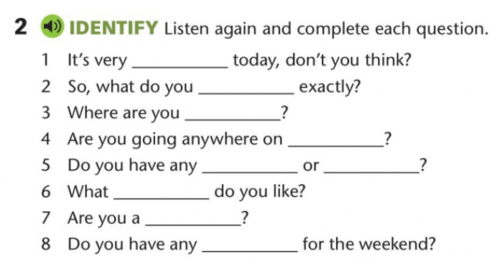
practicing daily conversations with strangers and acquaintances.
忙しい方、やり方が不明な方は
代行リクエストを依頼する
レッスンの詳細
warm up:
I begin by asking the learner how their day is going and about the weather. I elicit what this type of conversation is called "small talk".
I ask them what topics are common in their culture for small talk, and in what settings it is common to have small talk. I also introduce the verb used with the phrase "have small talk". I also ask if there are any inappropriate topics to talk about in their culture.
I show them the photo of the two women talking and ask where they are and what they might be talking about.
listening 1:
I explain that we are going to listen to 8 questions which are common in small talk in western culture. The goal is to match each question to a topic from the list.
listening 2:
Now we listen one more time to notice the language used in the questions and clear up grammatical differences between BE and DO questions. We expand on more questions and I invite the learner to engage in a little role play of small talk where we answer real questions from our lives.
focus on language:
In this part, I show the dictionary snippet and and introduce phrases to respond and show interest in small talk. We listen one more time to write down phrases that show interest. We have sentences to practice with. The learner says the sentences with interest according to the previous part.
flexi/extra stage:
Now we listen to pairs of sentences and notice the "friendly, interested" intonation versus the uninterested intonation. This models the appropriate rhythm for the learner for the last time, and is the last thing the learner takes with them by the end of the lesson.
I begin by asking the learner how their day is going and about the weather. I elicit what this type of conversation is called "small talk".
I ask them what topics are common in their culture for small talk, and in what settings it is common to have small talk. I also introduce the verb used with the phrase "have small talk". I also ask if there are any inappropriate topics to talk about in their culture.
I show them the photo of the two women talking and ask where they are and what they might be talking about.
listening 1:
I explain that we are going to listen to 8 questions which are common in small talk in western culture. The goal is to match each question to a topic from the list.
listening 2:
Now we listen one more time to notice the language used in the questions and clear up grammatical differences between BE and DO questions. We expand on more questions and I invite the learner to engage in a little role play of small talk where we answer real questions from our lives.
focus on language:
In this part, I show the dictionary snippet and and introduce phrases to respond and show interest in small talk. We listen one more time to write down phrases that show interest. We have sentences to practice with. The learner says the sentences with interest according to the previous part.
flexi/extra stage:
Now we listen to pairs of sentences and notice the "friendly, interested" intonation versus the uninterested intonation. This models the appropriate rhythm for the learner for the last time, and is the last thing the learner takes with them by the end of the lesson.




カフェトークの キャンセルポリシー
リクエスト確定前
- いつでも無料キャンセル可能。
リクエスト確定後
- レッスン開始時刻の24時間以上前→ いつでもキャンセル可能。
- レッスン開始時刻の24時間未満→ キャンセル料がかかる場合があります。
-
レッスンに現れなかった場合→ キャンセル料がかかる場合があります。
(キャンセル料については、講師に直接ご確認ください)



